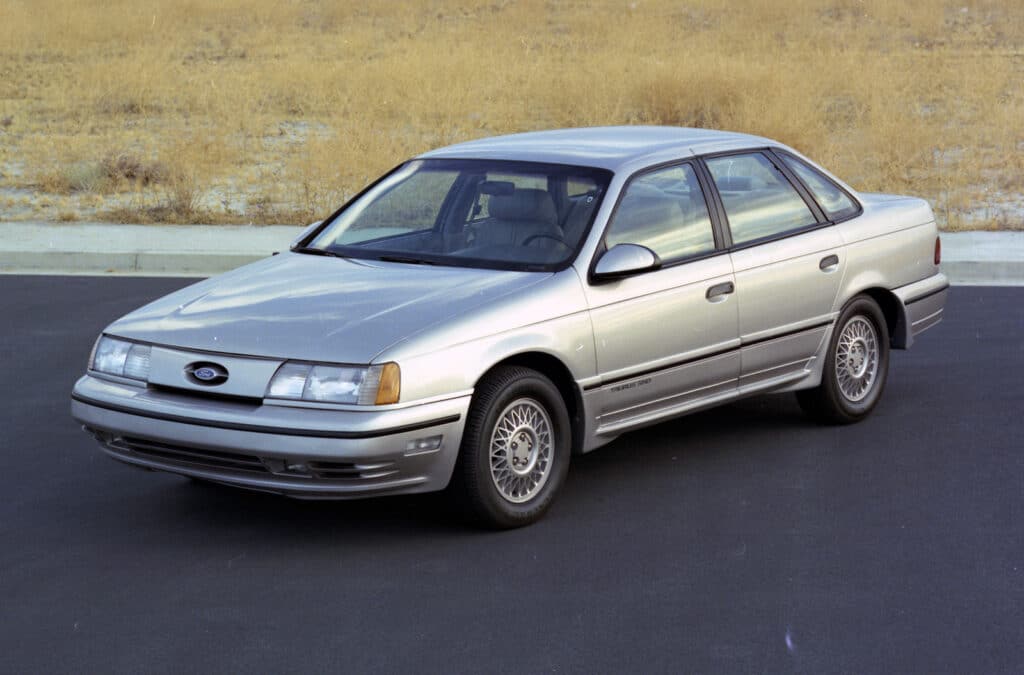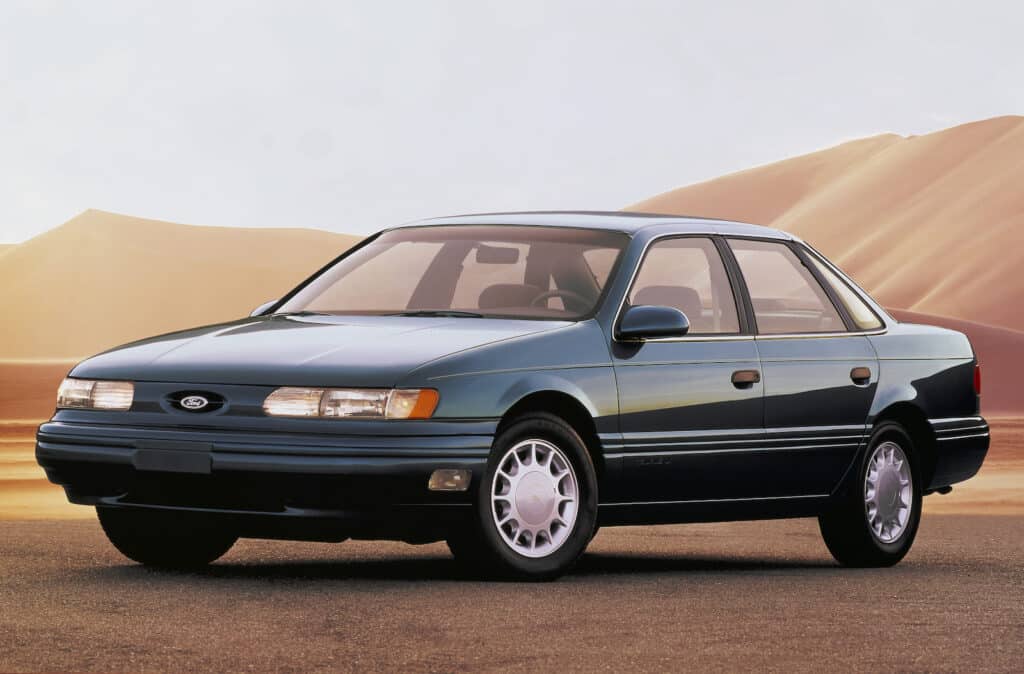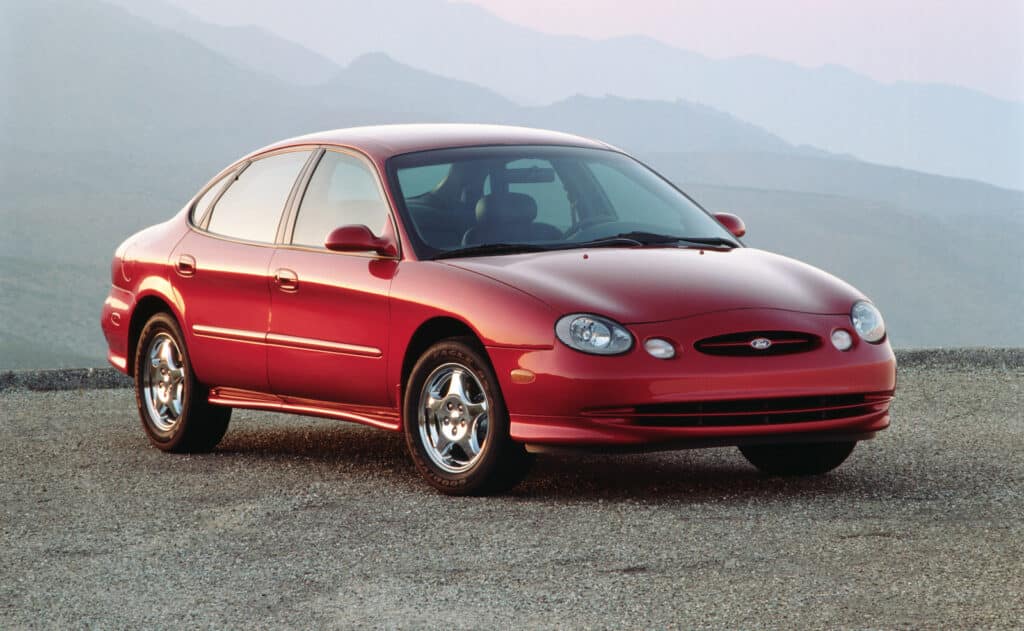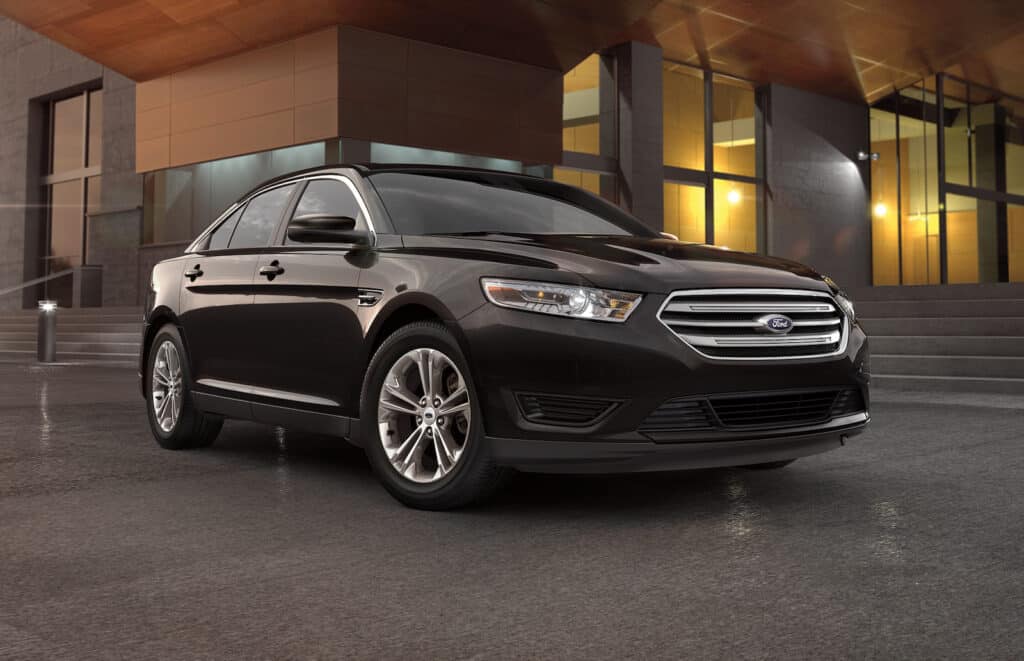The Rearview Mirror: The Last Bestselling American Sedan
It’s March 13, 1980, and Ford Motor Co. makes history, when Philip Caldwell succeeds Henry Ford II as company chairman, the first non-family member to run the automaker. He is joined by Donald Peterson as company president, who had a hand in creating the Ford Mustang and risen quickly through the ranks.
But the Ford Motor Co. they inherited was a mess.
Peterson looks for an answer

Ford’s cars of the time reflected older, traditional tastes, with staid boxy styling, vinyl roof trim and stand-up hood ornaments. Peterson visited Ford’s design studios, where he saw more of the same outdated design approach that would lead the company to lose an astounding $3.3 billion between 1980 and 1982. Ford’s own focus groups were revealing that younger buyers had never driven a Ford, and/or wouldn’t consider one.
So Peterson asked designer Jack Telnack, who was overseeing the redesign of the 1983 Ford Thunderbird, if the new Thunderbird he had created was one he would drive himself. When Telnack said, “No way,” Peterson suggested designing something he would like.
Free of the outdated Brougham-era 70s style that had calcified Detroit design, Telnack came out with the daringly aerodynamic 1983 Thunderbird, followed the next year by the Ford Tempo and Mercury Topaz compacts. Derided by former Ford President Lee Iacocca as “potato” cars, their different approach to design was luring customers back to Ford showrooms.
Meanwhile, Japanese competition was intensifying. Honda was opening its first car plant in Marysville, Ohio, while Toyota was partnering with General Motors at its NUMMI joint-venture plant in Fremont, California.
Clearly, something had to be done. Caldwell wanted to prove that Ford could compete with the Japanese.
A turning point

The heart of the American car market at the time was the midsize family car, an area where General Motors’ Oldsmobile Cutlass Supreme reigned supreme. To challenge Oldsmobile, Ford was developing a new family car under the name Project Sigma with the intention of creating a world class family sedan.
But to get it, Caldwell knew that it couldn’t be designed in the typical manner, where car development started in design before being dumped over the wall to engineers, then manufacturing, and finally to marketing. Instead, all teams were located together, so that the car avoided getting bogged down in fiefdoms, or become subjected to one department’s priorities at the expense of another’s.
The team decided to design the car with a decidedly aerodynamic look, with rounded corners, not right-angle ones. Ford had already fielded the Thunderbird and Tempo, and employed some modest aerodynamic updates to its midsize LTD sedan.
But this car’s look would go further, wearing a distinct appearance not unlike that of the new Audi 5000. But the aero appearance would do more than stand apart from its competition, giving the car a fast, sporty look, while helping improve fuel economy. Executives were nervous about the front end, which lacked a front grille — a radical treatment at the time. In fact, Ford executives were so nervous about the pubic accepting the new Taurus, they kept producing the boxy, Fairmont-based Ford LTD and Mercury Marquis, in case the Taurus and its sibling, the Mercury Sable, were a flop. They had no need to worry, as it turns out.

Offered as a sedan or station wagon, the front-wheel-drive Ford Taurus and Mercury Sable, started at $10,000, and became certified smashes. Better yet, Ford was clearing a profit of $2,500 per car. The car became fashionable, a Detroit car that consumers were proud to drive at a time when Detroit to many was an anathema.
Despite a series of recalls, the cars flew off dealer lots, possessing the same design élan as Braun coffeemakers or a Crate and Barrell couch. The competition could only look on in disbelief, their cars looking as square as a box of cereal. By 1987, Ford’s pretax profits hit an all-time record of $5.1 billion, nearly double that of General Motors and the first time the company outearned GM since 1924.
While GM tried to figure out Ford’s secret sauce, the Japanese flattered Ford by following in their footsteps, the first salvo being the 1988 Toyota Camry, which eschewed the first generation’s slab-sided style for one far more rounded. Honda followed with a new Accord in 1989. Other OEMs would follow suit. But Ford managed to hold its lead. In 1992, the Taurus was modestly restyled, becoming the bestselling car in the United States, a position it would hold through 1996.
A failure in design and marketing
But the Japanese kept upping their game, as Toyota introduced a new Camry for 1992 designed by the team that had designed the first Lexus LS. The new Camry was overengineered for its price, and to many called to mind a miniature LS at half the price. Ford saw the challenge, and was determined to meet it.

The new team assembled to redesign the Taurus were determined to make it as revolutionary as the first one. So the team decided to push the car slightly upmarket. But in the meantime, Ford’s marketing arm was using everything at its disposal to keep the current Taurus at the top of the charts by piling on incentives, cheap lease deals and flooding rental car fleets with Taurus models. This devalued the car just before Ford was about to push it upmarket.
But the team also miscalculated on the new car’s styling for 1996. Instead of developing the current car’s look, they went in a new direction, using ovoid shapes throughout the car, pushing it far away from the look buyers had come to like and expect. Then there was the price, which was far higher than the $199 a month lease deals that had, until mere months before, been associated with the Taurus. Instead, they found a car that started at $20,000 and topped out at nearly $23,000. Now uglier and more expensive, it fell from first place to third, behind the Camry and Accord.
But rather than redesign the car and protect the franchise, Ford poured money into higher margins SUVs. It would take Ford until 2000 to update the car’s appearance and tone down its ovoid excess. But it seemed as if Ford no longer cared about its one-time star car. By 2002, the company wasn’t even advertising it.
Yet it hung on through 2006 before going on hiatus, returning as a facelifted version of the Ford 500 in 2008. It would continue to be built through 2019, with production ending after a production run of more than 8 million cars, making it the fifth-best-selling North American nameplate in Ford’s history.
Only the F-150, Escort, Model T, and Mustang have sold more.
Auto Lovers Land
Comments
Post a Comment